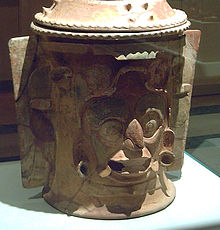- Maya jaguar gods
-
The pre-Columbian Maya civilization had various jaguar gods, in addition to jaguar demi-gods, (ancestral) protectors, and transformers. The main jaguar deities are given below. Their associated narratives (part of Maya mythology) are still largely to be reconstructed. Lacandon and Tzotzil-Tzeltal oral tradition are particularly rich in jaguar lore.
Contents
The Jaguar God of Terrestrial Fire
The Jaguar God of Terrestrial Fire is recognizable by a 'cruller' around the eyes (making a loop over the nose), jaguar ears, and jaguar fangs. He personifies the number Seven, which is associated with the day Ak'b'al 'Night'. Usually called 'Jaguar God of the Underworld', he has traditionally been assumed to be the 'Night Sun', i.e., the shape taken by the sun (Kinich Ahau) during his nightly journey through the underworld. There is little to validate this view; what we do know is, that the so-called Jaguar God of the Underworld was identified with a star or constellation (rather than with the sun), and with terrestrial fire. He is often represented on incense burners, and is connected to fire rituals. The 'cruller' may represent a cord used in making fire with a stick. Vases in codical style show him, captured, about to be burnt with torches, perhaps initiating his stellar transformation. The god's other sphere of influence is that of war, witness for example the stereotypical presence of his face on several war shields.
God L
God L (according to the designation of codical gods), one of the oldest Mayan deities, and associated with black sorcery and riches, belongs to the jaguar deities: He has jaguar ears and a jaguar mantle and lives in a jaguar palace. Some take him to be the main ruler over the Underworld, and in that sense, god L would have to be considered the true "Jaguar God of the Underworld".
The Jaguar Goddess of Midwifery and War
The aged goddess of midwifery, curing, and war Ix Chel, belongs to the jaguar deities. She has jaguar ears and claws and can show the looped cruller element of the Jaguar God of Terrestrial Fire (Birth Vase), suggesting that she might be a spouse to this deity.
The Jaguar Patron of the month of Pax
The patron deity of the month of Pax has jaguar paws above his ears, a removed lower jaw, and vomits blood. In 16th-century Yucatan, rituals held in the month of Pax centered on the war leader and the puma deity, Cit Chac Coh. Particularly scenes on pottery show the Pax deity to be intimately associated with war and human sacrifice. He presides over the transformation of a child into a jaguar (see below) and performs a sacrificial dance around the captured Rain Deity (Chaac). Personified as a tree, he witnesses the shooting of the Principal Bird Deity and of the Vulture King by Hun-Ahpu.
The Aged Jaguar Paddler
One of two aged deities steering the canoe with the Tonsured Maize God has a jaguar headdress and is associated with Night, like the Jaguar God of Terrestrial Fire. Little else is known about him.
The Jaguar Twin Hero
The protective War Hero Twin of the Popol Vuh, Xbalanque, has patches of jaguar pelt stuck to his skin.
Jaguar Protectors and Jaguar Transformers
Less clearly classifiable as deities are jaguar protectors (perhaps ancestors) and jaguar transformers. The Water Lily Jaguar (so called because of the water lily on its head) is both a giant jaguar protector, looming large above the king (e.g., Tikal wooden lintel 3, temple I), and a transformer often shown amidst flames. A specific and as yet unexplained transformation into a jaguar involves a male child with jaguar ears and a jaguar tail (the so-called Jaguar Baby). This Jaguar Baby can assume the features of the Jaguar God of Terrestrial Fire.
References
- Mary Miller and Karl Taube, The Gods of Ancient Mexico and the Maya. Thames and Hudson.
- David Stuart, 'The Fire Enters His House': Architecture and Ritual in Classic Maya Texts', in Houston, Function and Meaning in Classic Maya Architecture (1998): 373-425.
- Karl Taube, The Major Gods of Ancient Yucatan. Washington, D.C.: Dumbarton Oaks, 1992.
See also
- Jaguars in Mesoamerican culture
Categories:- Maya deities
Wikimedia Foundation. 2010.

